Assessment of Electromagnetic Exposure Levels for Humans from Electric Vehicle DC Charging Stations
Abstract
1. Introduction
2. Model Construction
2.1. Human Model Description
2.2. DC Charging Station Model
2.3. Dielectric Parameters of Human Tissue
2.4. Numerical Methods
2.5. ICNIRP Exposure Limits
3. Electromagnetic Exposure Safety Assessment
3.1. B-Field Distribution of the DC Charging Station
3.2. B-Field Distribution Within Adult and Child at Different Distances
3.3. E-Field Distribution Within Adults and Children at Different Distances
3.4. B-Field Distribution in Car
3.5. Driver’s Body B-Field Distribution
3.6. Driver’s Body E-Field Distribution
3.7. Electromagnetic Exposure Levels at Different Frequencies
4. Conclusions
- (1)
- For an adult standing 0.1 m from the charging pile, the peak B-field (1.91 µT) and the peak E-field (447 mV/m) in the body are 1.91% and 2.07% of the ICNIRP occupational exposure limits, respectively, and 7.07% and 4.14% of the public exposure limits. For the child, the electromagnetic exposure levels (2.31 µT and 259 mV/m) are 8.56% and 2.40% of the public exposure limits, respectively. These results indicate that electromagnetic exposure levels for occupational and private individuals near the DC charging pile are within safe limits.
- (2)
- For an adult standing at distances of 0.1 m, 0.3 m, and 0.6 m from the DC charging pile, the peak B-field in the body corresponds to 7.07%, 3.02%, and 0.80% of the ICNIRP public exposure limits, respectively, while the peak E-field corresponds to 2.07%, 1.77%, and 0.44%. For a child at the same distances, the peak B-field is 8.56%, 3.45%, and 2.15% of the ICNIRP public exposure limits, and the peak E-field is 2.40%, 1.74%, and 1.43%. These findings demonstrate a significant negative correlation between the distance from the charging pile and the electromagnetic exposure level in the body.
- (3)
- During electric vehicle charging, the peak B-fields in the body for an adult in the driver’s seat and a child in the passenger’s seat are 0.0225 × 10−2 µT and 0.0237 × 10−2 µT, respectively. The peak E-fields in the body and brain are 5.81 mV/m and 5.59 mV/m for the adult, and 5.82 mV/m and 5.67 mV/m for the child, all significantly below the ICNIRP public exposure limits.
- (4)
- In the typical scenarios (adult at 0.1 m from the charging pile), analyses were conducted at multiple frequency bands, including 85 kHz, 90 kHz, and 95 kHz. The results show that as the frequency increases, the peak B-field in the human body gradually decreases, while the E-field in the body shows no significant change, possibly influenced by the vehicle body. The electromagnetic exposure levels in all frequency bands are below the ICNIRP safety limits.
Author Contributions
Funding
Institutional Review Board Statement
Informed Consent Statement
Data Availability Statement
Conflicts of Interest
References
- Martins, F.; Felgueiras, C.; Smitkova, M.; Caetano, N. Analysis of Fossil Fuel Energy Consumption and Environmental Impacts in European Countries. Energies 2019, 12, 964. [Google Scholar] [CrossRef]
- Zhou, X.; Feng, C. The Impact of Environmental Regulation on Fossil Energy Consumption in China: Direct and Indirect Effects. J. Clean. Prod. 2017, 142, 3174–3183. [Google Scholar] [CrossRef]
- Citroni, R.; Mangini, F.; Frezza, F. Efficient Integration of Ultra-Low Power Techniques and Energy Harvesting in Self-Sufficient Devices: A Comprehensive Overview of Current Progress and Future Directions. Sensors 2024, 24, 4471. [Google Scholar] [CrossRef]
- Sun, D.; Kyere, F.; Sampene, A.K.; Asante, D.; Kumah, N.Y.G. An Investigation on the Role of Electric Vehicles in Alleviating Environmental Pollution: Evidence from Five Leading Economies. Environ. Sci. Pollut. Res. 2023, 30, 18244–18259. [Google Scholar] [CrossRef]
- Xiaoqin, W.; Hu, L.; Qiaolin, R.; Yan, W.; Wei, X. Overview of the Development and Related Research of Electric Vehicles. In Proceedings of the 2017 2nd International Conference on Power and Renewable Energy (ICPRE), Chengdu, China, 20–23 September 2017; pp. 814–818. [Google Scholar]
- Szumska, E.M. Electric Vehicle Charging Infrastructure along Highways in the EU. Energies 2023, 16, 895. [Google Scholar] [CrossRef]
- Pettersson, S. Lightweight Infrastructure for Electric Vehicle Charging. World Electr. Veh. J. 2015, 7, 631–642. [Google Scholar] [CrossRef]
- Chen, Y. Infrastructure for Charging Electric Vehicles’ Effect on Sales in China: Regional Variations and Policy Implications. SHS Web Conf. 2024, 207, 4005. [Google Scholar] [CrossRef]
- Qiao, S. Technical Analysis and Research on DC Charging Pile of Electric Vehicle. In Proceedings of the 2021 International Conference on Smart City and Green Energy (ICSCGE), Hangzhou, China, 20–22 November 2021; pp. 89–93. [Google Scholar]
- Levinson, R.S.; West, T.H. Impact of Public Electric Vehicle Charging Infrastructure. Transp. Res. Part D Transp. Environ. 2018, 64, 158–177. [Google Scholar] [CrossRef]
- Lim, K.L.; Speidel, S.; Bräunl, T. A Comparative Study of AC and DC Public Electric Vehicle Charging Station Usage in Western Australia. Renew. Sustain. Energy Transit. 2022, 2, 100021. [Google Scholar] [CrossRef]
- Zheng, J.; Wang, H.; Tong, X.; Feng, X. Planning and Deployment Method of Electric Vehicle Charging Facilities in a Self-Consistent Highway Transportation Energy System. In Proceedings of the 2023 IEEE 6th International Electrical and Energy Conference (CIEEC), Hefei, China, 12–14 May 2023; pp. 466–471. [Google Scholar]
- Wu, W.; Liu, X.; Huang, C. A DC Charging Pile for New Energy Electric Vehicles. J. Electr. Eng. Technol. 2023, 18, 4301–4319. [Google Scholar] [CrossRef]
- Rocha, J.; Amin, S.; Coelho, S.; Rego, G.; Afonso, J.L.; Monteiro, V. Design and Implementation of a DC–DC Resonant LLC Converter for Electric Vehicle Fast Chargers. Energies 2025, 18, 1099. [Google Scholar] [CrossRef]
- Tokpınar, A.; Altuntaş, E.; Değermenci, M.; Yılmaz, H.; Bas, O. The Impact of Electromagnetic Fields on Human Health: A Review. Middle Black Sea J. Health Sci. 2024, 10, 229–238. [Google Scholar] [CrossRef]
- Dong, X.; Sun, W.; Lu, M. Evaluation of Electromagnetic Fields in Human Body Exposed to Inverter of Pure Electric Vehicle. Radiat. Prot. Dosim. 2023, 199, 216–229. [Google Scholar] [CrossRef]
- Vassilev, A.; Ferber, A.; Wehrmann, C.; Pinaud, O.; Schilling, M.; Ruddle, A.R. Magnetic Field Exposure Assessment in Electric Vehicles. IEEE Trans. Electromagn. Compat. 2015, 57, 35–43. [Google Scholar] [CrossRef]
- Yang, L.; Lu, M.; Lin, J.; Li, C.; Zhang, C.; Lai, Z.; Wu, T. Long-Term Monitoring of Extremely Low Frequency Magnetic Fields in Electric Vehicles. Int. J. Environ. Res. Public Health 2019, 16, 3765. [Google Scholar] [CrossRef] [PubMed]
- Bazhynov, A.V.; Kravtsov, M.M. Electromagnetic danger of electric and hybrid vehicles. J. Mech. Eng. Transp. 2024, 18, 3–9. [Google Scholar] [CrossRef]
- Moreno-Torres Concha, P.; Velez, P.; Lafoz, M.; Arribas, J.R. Passenger Exposure to Magnetic Fields Due to the Batteries of an Electric Vehicle. IEEE Trans. Veh. Technol. 2016, 65, 4564–4571. [Google Scholar] [CrossRef]
- Hasselgren, L.; Mademlis, G.; Lindbeck, Å.; Dahl, O. Inverter Interference on Charging Communication System during 400 V DC Charging of Vehicle. In Proceedings of the 2022 International Symposium on Electromagnetic Compatibility–EMC Europe, Gothenburg, Sweden, 5–8 September 2022; pp. 473–478. [Google Scholar]
- Lennerz, C.; Schaarschmidt, C.; Blažek, P.; Knoll, K.; Kottmaier, M.; Reents, T.; Bourier, F.; Lengauer, S.; Popa, M.; Wimbauer, K.; et al. High-Power Chargers for Electric Vehicles: Are They Safe for Patients with Pacemakers and Defibrillators? Europace 2023, 25, euad042. [Google Scholar] [CrossRef]
- Park, S. Evaluation of Electromagnetic Exposure During 85 kHz Wireless Power Transfer for Electric Vehicles. IEEE Trans. Magn. 2018, 54, 5100208. [Google Scholar] [CrossRef]
- Zhao, J.; Wu, Z.-J.; Li, N.-L.; Yang, T. Study on Safe Distance between Human Body and Wireless Charging System of Electric Vehicles with Different Power and Frequencies. Electr. Eng. 2020, 102, 2281–2293. [Google Scholar] [CrossRef]
- Laakso, I.; Hirata, A. Evaluation of the Induced Electric Field and Compliance Procedure for a Wireless Power Transfer System in an Electrical Vehicle. Phys. Med. Biol. 2013, 58, 7583–7593. [Google Scholar] [CrossRef]
- Lu, M.; Ueno, S. Safety Assessment of H-Coil for Nursing Staff in Deep Transcranial Magnetic Stimulation. IEEE Magn. Lett. 2022, 13, 3104805. [Google Scholar] [CrossRef]
- He, Y.; Liu, M.; Liu, X.; Zheng, X.; Zeng, G.; Zhang, J. DC Transformer Compensation for Efficiency Improvement of Electric Vehicles Wireless Charging Systems. Prog. Electromagn. Res. C 2019, 90, 265–279. [Google Scholar] [CrossRef]
- Di Paolo, M. Analysis of Harmonic Impact of Electric Vehicle Charging on the Electric Power Grid, Based on Smart Grid Regional Demonstration Project—Los Angeles. In Proceedings of the 2017 IEEE Green Energy and Smart Systems Conference (IGESSC), Long Beach, CA, USA, 6–7 November 2017; pp. 1–5. [Google Scholar]
- Mazurek, P.; Chudy, A. An Analysis of Electromagnetic Disturbances from an Electric Vehicle Charging Station. Energies 2021, 15, 244. [Google Scholar] [CrossRef]
- Nacu, R.C.; Fodorean, D. Harmonics Mitigation in DC Based Charging Stations for EVs. In Proceedings of the 2021 10th International Conference on Renewable Energy Research and Application (ICRERA), Istanbul, Turkey, 26 September 2021; pp. 226–230. [Google Scholar]
- Zheng, Z.; Zhang, D. Study on Electromagnetic Compatibility of DC Charging Pile. In Proceedings of the 2018 China International Conference on Electricity Distribution (CICED), Tianjin, China, 17–19 September 2018; pp. 2805–2810. [Google Scholar]
- Trentadue, G.; Pinto, R.; Salvetti, M.; Zanni, M.; Pliakostathis, K.; Scholz, H.; Martini, G. Assessment of Low-Frequency Magnetic Fields Emitted by DC Fast Charging Columns. Bioelectromagnetics 2020, 41, 308–317. [Google Scholar] [CrossRef]
- Trentadue, G.; Pinto, R.; Zanni, M.; Scholz, H.; Pliakostathis, K.; Martini, G. Low Frequency Magnetic Fields Emitted by High-Power Charging Systems. Energies 2020, 13, 1594. [Google Scholar] [CrossRef]
- Bae, H.; Park, S. Assessment of the Electromagnetic Radiation Exposure at EV Charging Facilities. Sensors 2023, 23, 162. [Google Scholar] [CrossRef] [PubMed]
- L’Annunziata, M.F. Handbook of Radioactivity Analysis; Academic Press: Cambridge, MA, USA, 2012; ISBN 978-0-12-384874-1. [Google Scholar]
- Furse, C.; Christensen, D.A.; Durney, C.H. Basic Introduction to Bioelectromagnetics, 2nd ed.; CRC Press: Boca Raton, FL, USA, 2009; ISBN 978-0-429-13674-0. [Google Scholar]
- Maruvada, P.S.; Jutras, P.; Plante, M. An Investigation to Identify Possible Sources of Electromagnetic Field Transients Responsible for Exposures Reported in Recent Epidemiological Studies. IEEE Trans. Power Deliv. 2000, 15, 266–271. [Google Scholar] [CrossRef]
- Misek, J.; Laukova, T.; Kohan, M.; Veternik, M.; Jakusova, V.; Jakus, J. Measurement of Low-Level Radiofrequency Electromagnetic Fields in the Human Environment. Acta Medica Martiniana 2018, 18, 27–33. [Google Scholar] [CrossRef]
- Litvinenko, A.; Yucel, A.C.; Bagci, H.; Oppelstrup, J.; Michielssen, E.; Tempone, R. Computation of Electromagnetic Fields Scattered from Objects with Uncertain Shapes Using Multilevel Monte Carlo Method. IEEE J. Multiscale Multiphysics Comput. Tech. 2019, 4, 37–50. [Google Scholar] [CrossRef]
- Gosselin, M.-C.; Neufeld, E.; Moser, H.; Huber, E.; Farcito, S.; Gerber, L.; Jedensjö, M.; Hilber, I.; Gennaro, F.D.; Lloyd, B.; et al. Development of a New Generation of High-Resolution Anatomical Models for Medical Device Evaluation: The Virtual Population 3.0. Phys. Med. Biol. 2014, 59, 5287. [Google Scholar] [CrossRef]
- Mou, W.; Lu, M. Dosimetry Simulation Research on Electromagnetic Exposure of Wireless Charging Electric Vehicle to Human Central Nervous System. In Proceedings of the 2021 IEEE 16th Conference on Industrial Electronics and Applications (ICIEA), Chengdu, China, 1–4 August 2021; pp. 609–614. [Google Scholar]
- Mou, W.; Lu, M. Safety Assessment of Wireless Chargers for Electric Vehicles Considering Thermal Characteristics. Radiat. Prot. Dosim. 2024, 200, 187–200. [Google Scholar] [CrossRef] [PubMed]
- Pethig, R. Dielectric Properties of Body Tissues. Clin. Phys. Physiol. Meas. 1987, 8, 5. [Google Scholar] [CrossRef] [PubMed]
- Gabriel, C.; Gabriel, S.; Corthout, E. The Dielectric Properties of Biological Tissues: I. Literature Survey. Phys. Med. Biol. 1996, 41, 2231–2249. [Google Scholar] [CrossRef]
- Gabriel, S.; Lau, R.W.; Gabriel, C. The Dielectric Properties of Biological Tissues: II. Measurements in the Frequency Range 10 Hz to 20 GHz. Phys. Med. Biol. 1996, 41, 2251–2269. [Google Scholar] [CrossRef]
- Gabriel, S.; Lau, R.W.; Gabriel, C. The Dielectric Properties of Biological Tissues: III. Parametric Models for the Dielectric Spectrum of Tissues. Phys. Med. Biol. 1996, 41, 2271–2293. [Google Scholar] [CrossRef]
- Webb, J.P. Application of the Finite-Element Method to Electromagnetic and Electrical Topics. Rep. Prog. Phys. 1995, 58, 1673. [Google Scholar] [CrossRef]
- Conchin Gubernati, A.; Freschi, F.; Giaccone, L.; Scorretti, R. Analysis of Numerical Artifacts Using Tetrahedral Meshes in Low Frequency Numerical Dosimetry. Appl. Sci. 2022, 12, 6526. [Google Scholar] [CrossRef]
- Ahlbom, A.; Bergqvist, U.; Bernhardt, J.H.; Cesarini, J.P.; Grandolfo, M.; Hietanen, M.; Mckinlay, A.F.; Repacholi, M.H.; Sliney, D.H.; Stolwijk, J.A.; et al. Guidelines for Limiting Exposure to Time-Varying Electric, Magnetic, and Electromagnetic Fields (up to 300 GHz). Health Phys. 1998, 74, 494–521. [Google Scholar]
- International Commission on Non-Ionizing Radiation Protection. Guidelines for Limiting Exposure to Time-Varying Electric and Magnetic Fields (1 Hz to 100 kHz). Health Phys. 2010, 99, 818–836. [Google Scholar] [CrossRef]
- Ziegelberger, G.; Croft, R.; Feychting, M.; Green, A.C.; Hirata, A.; D’Inzeo, G.; Jokela, K.; Loughran, S.; Marino, C.; Miller, S.; et al. Guidelines for Limiting Exposure to Electromagnetic Fields (100 kHz to 300 GHz). Health Phys. 2020, 118, 483–524. [Google Scholar] [CrossRef]
- IEEE Std C95.1-2019 (Revision of IEEE Std C95.1-2005/Incorporates IEEE Std C95.1-2019/Cor 1-2019); IEEE Standard for Safety Levels with Respect to Human Exposure to Electric, Magnetic, and Electromagnetic Fields, 0 Hz to 300 GHz. IEEE: New York, NY, USA, 2019; pp. 1–312. [CrossRef]
- Duyn, J.H.; Schenck, J. Contributions to Magnetic Susceptibility of Brain Tissue. NMR Biomed. 2017, 30, e3546. [Google Scholar] [CrossRef] [PubMed]
- Liu, J.; Wang, Y.; Katscher, U.; He, B. Electrical Properties Tomography Based on Maps in MRI: Principles, Applications, and Challenges. IEEE Trans. Biomed. Eng. 2017, 64, 2515–2530. [Google Scholar] [CrossRef] [PubMed]

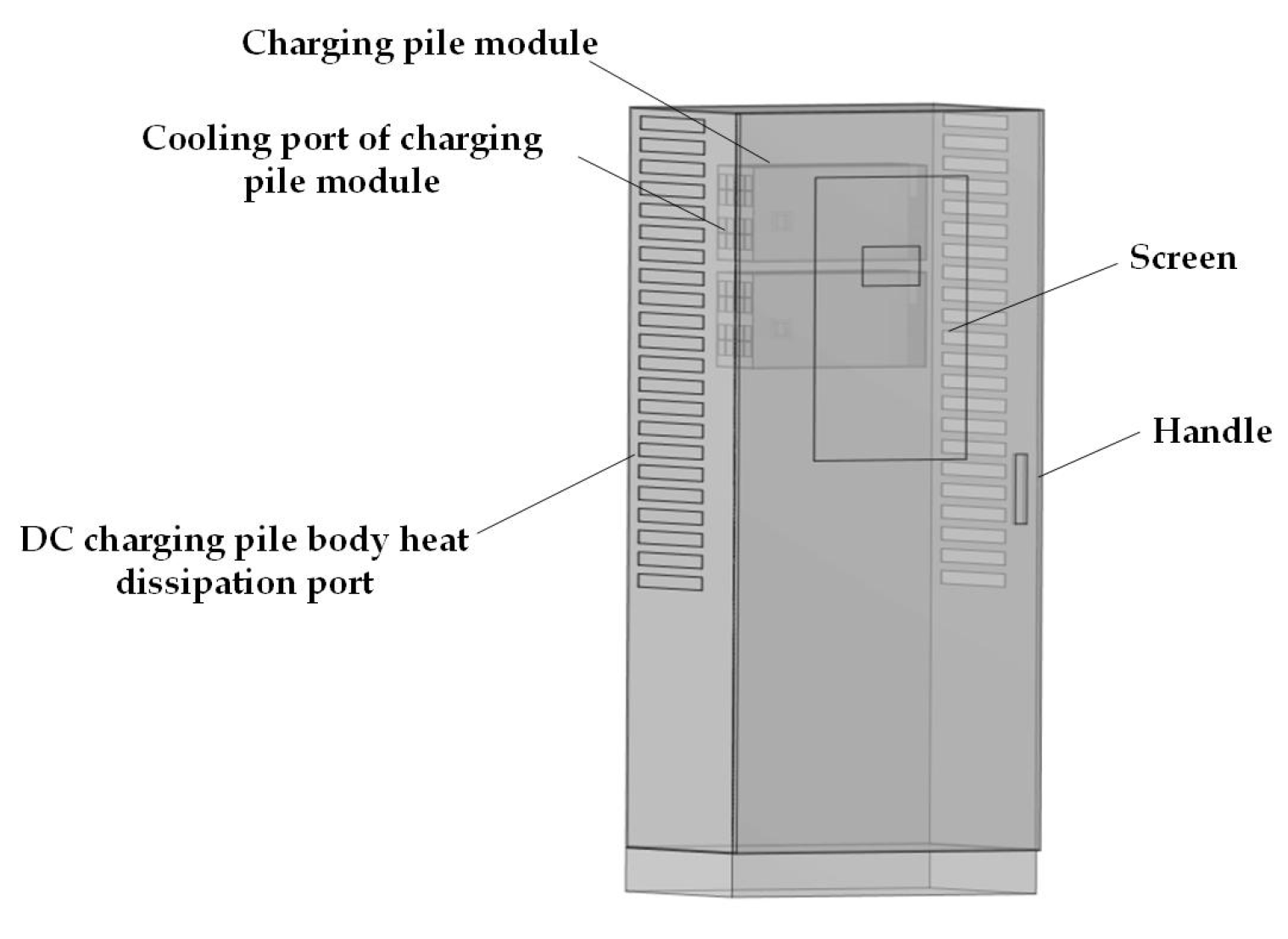
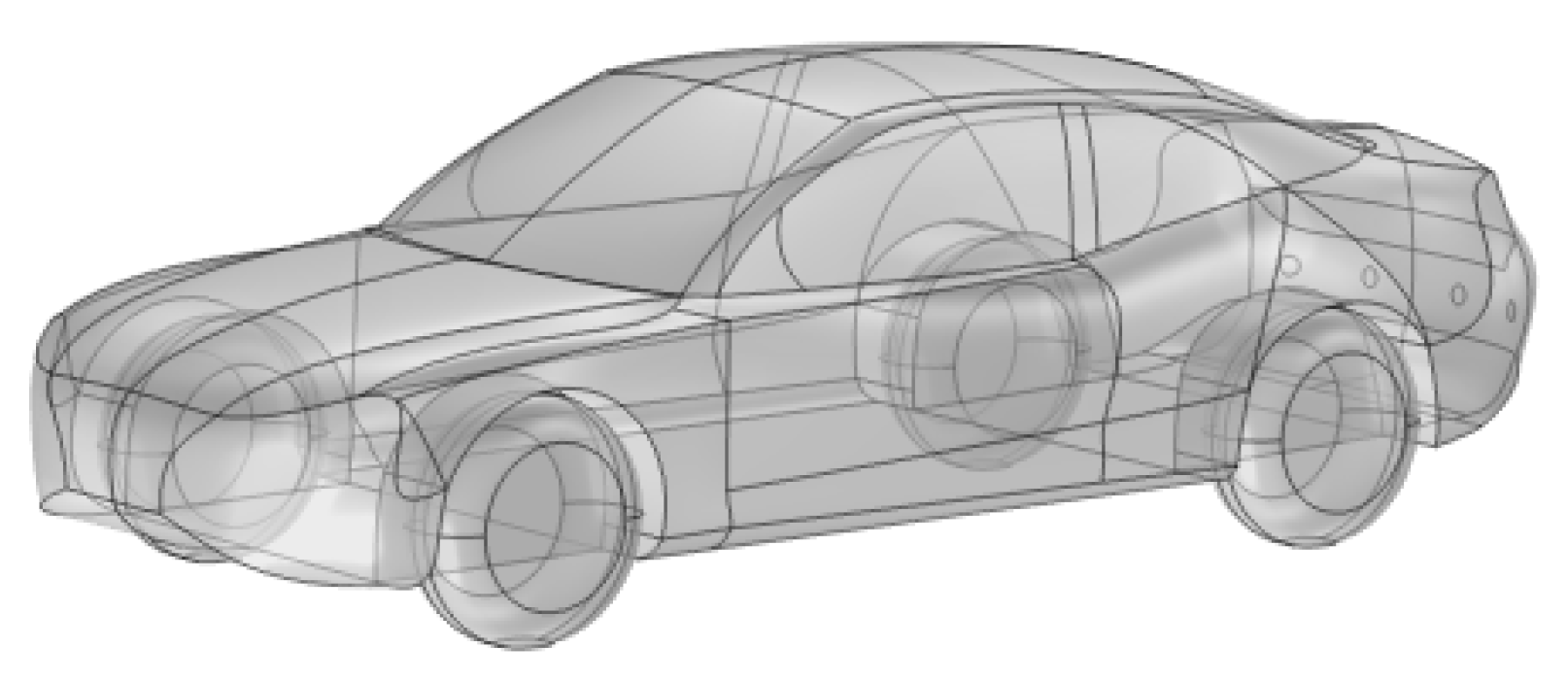
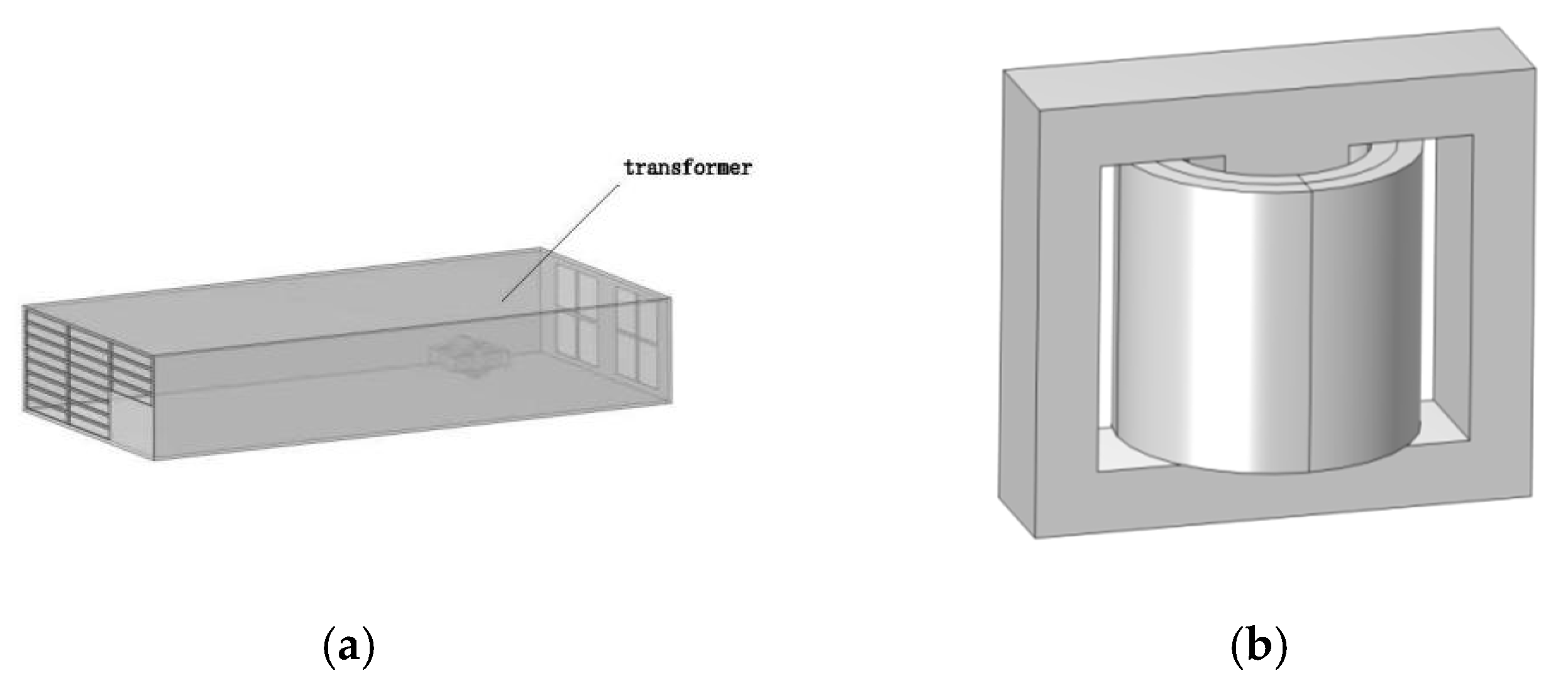




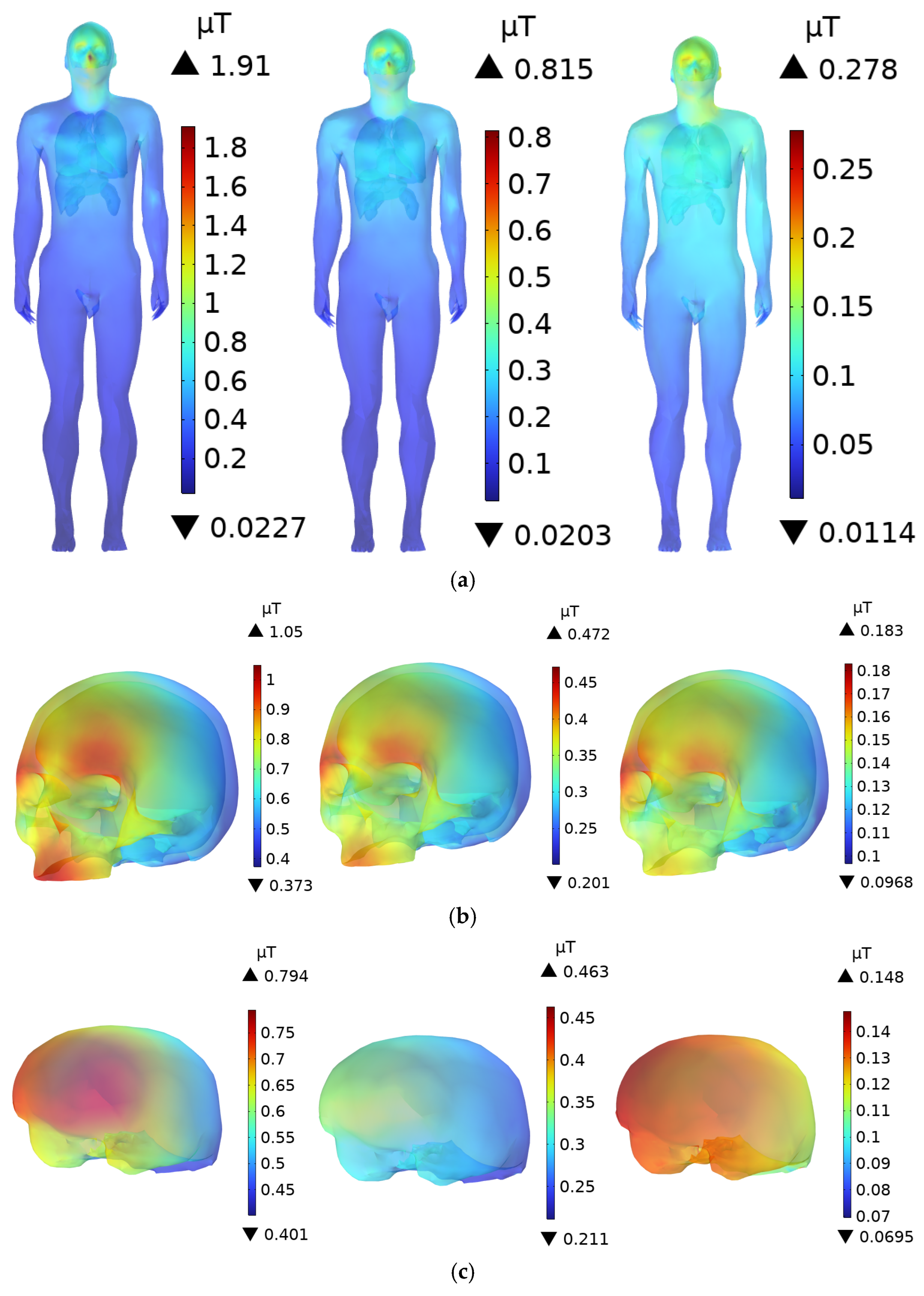
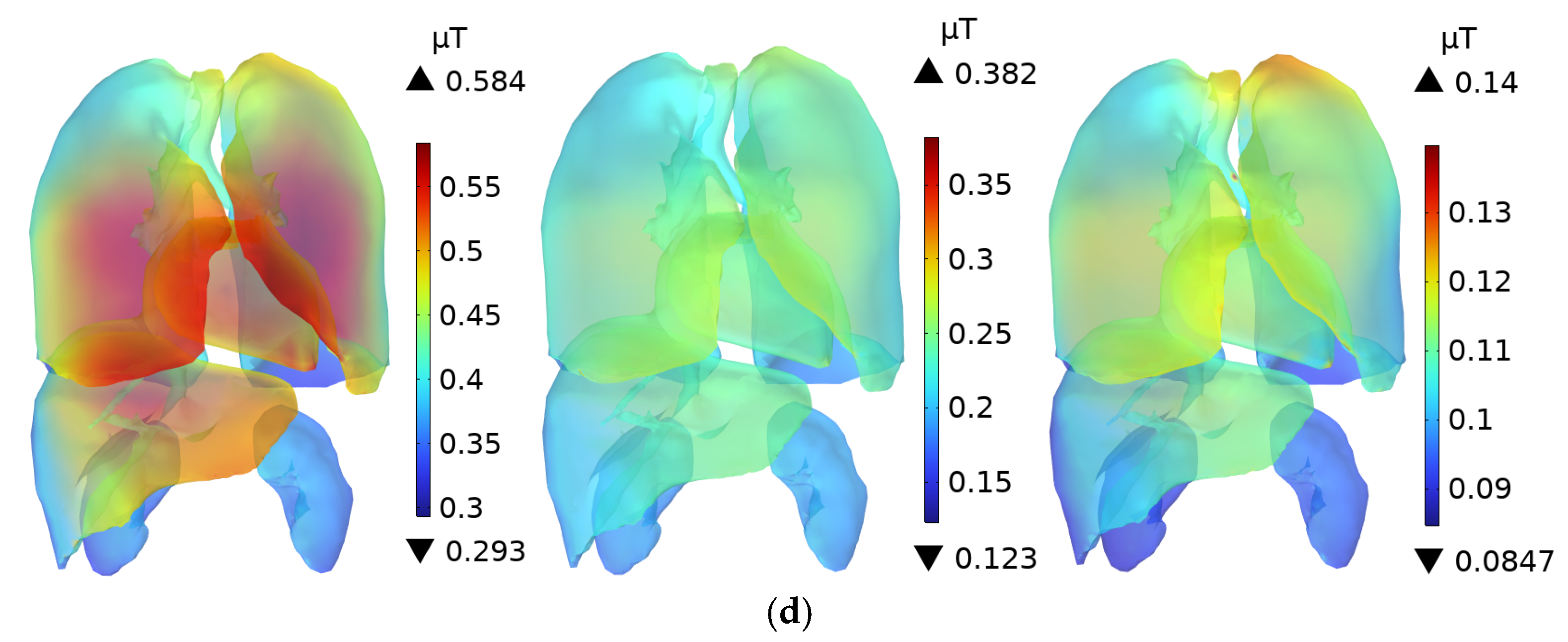



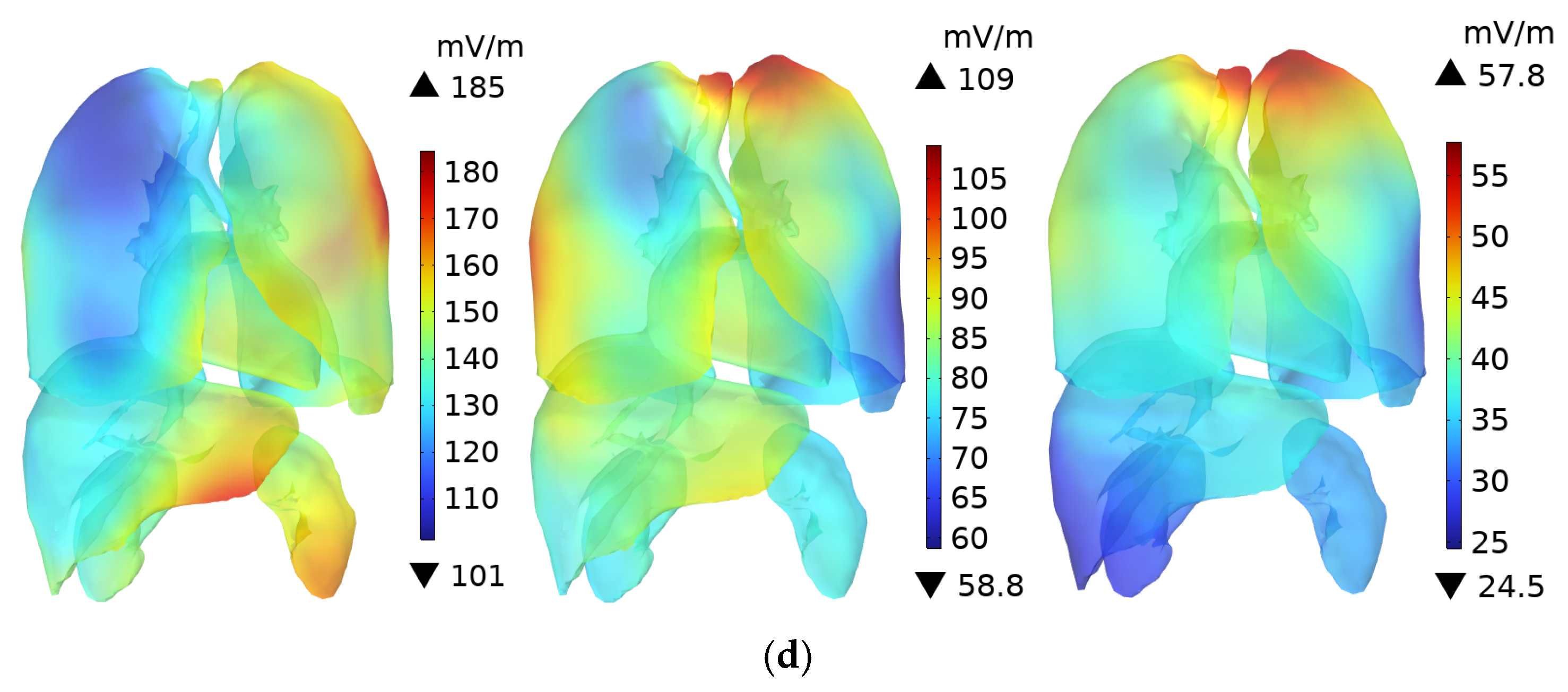
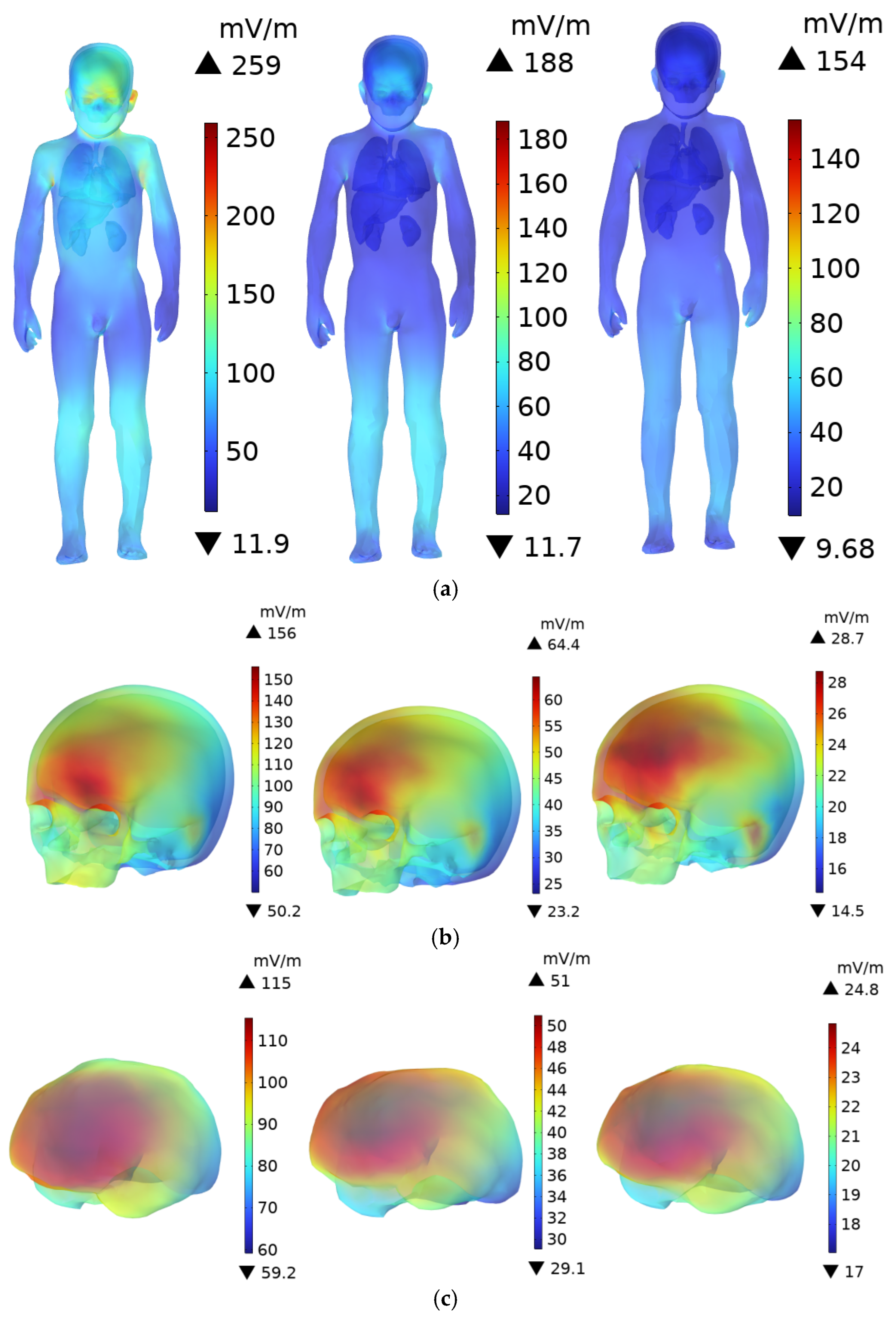
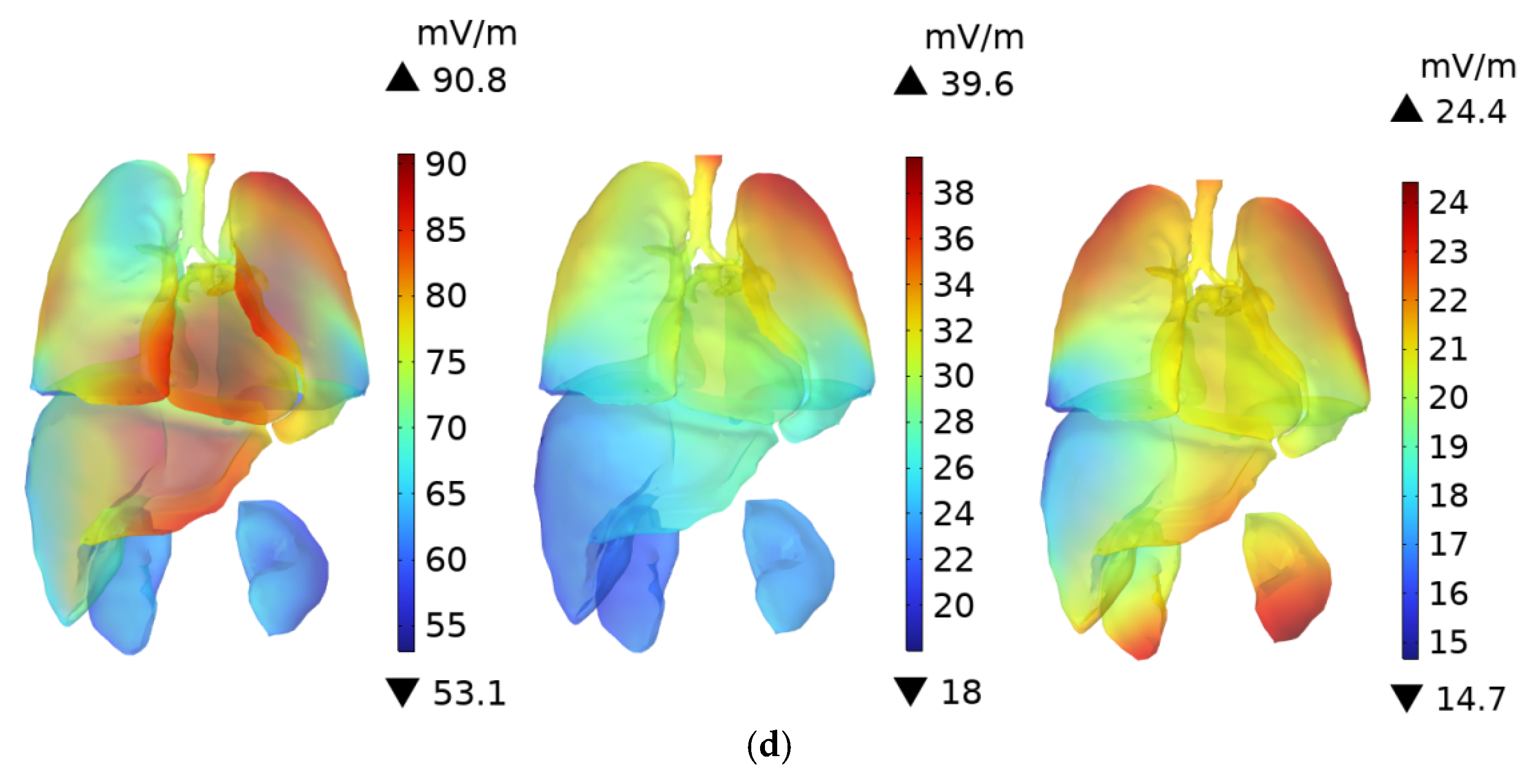
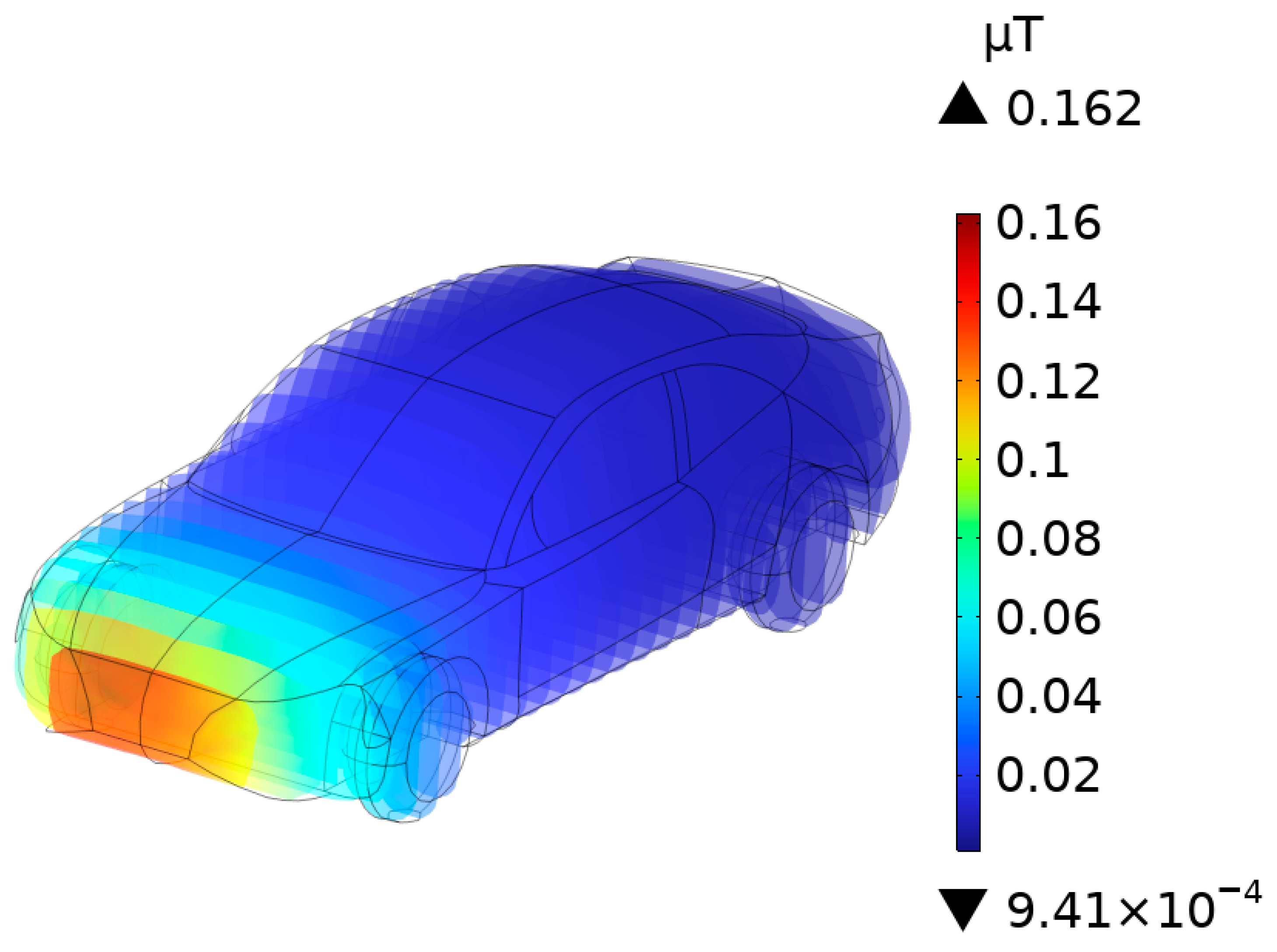



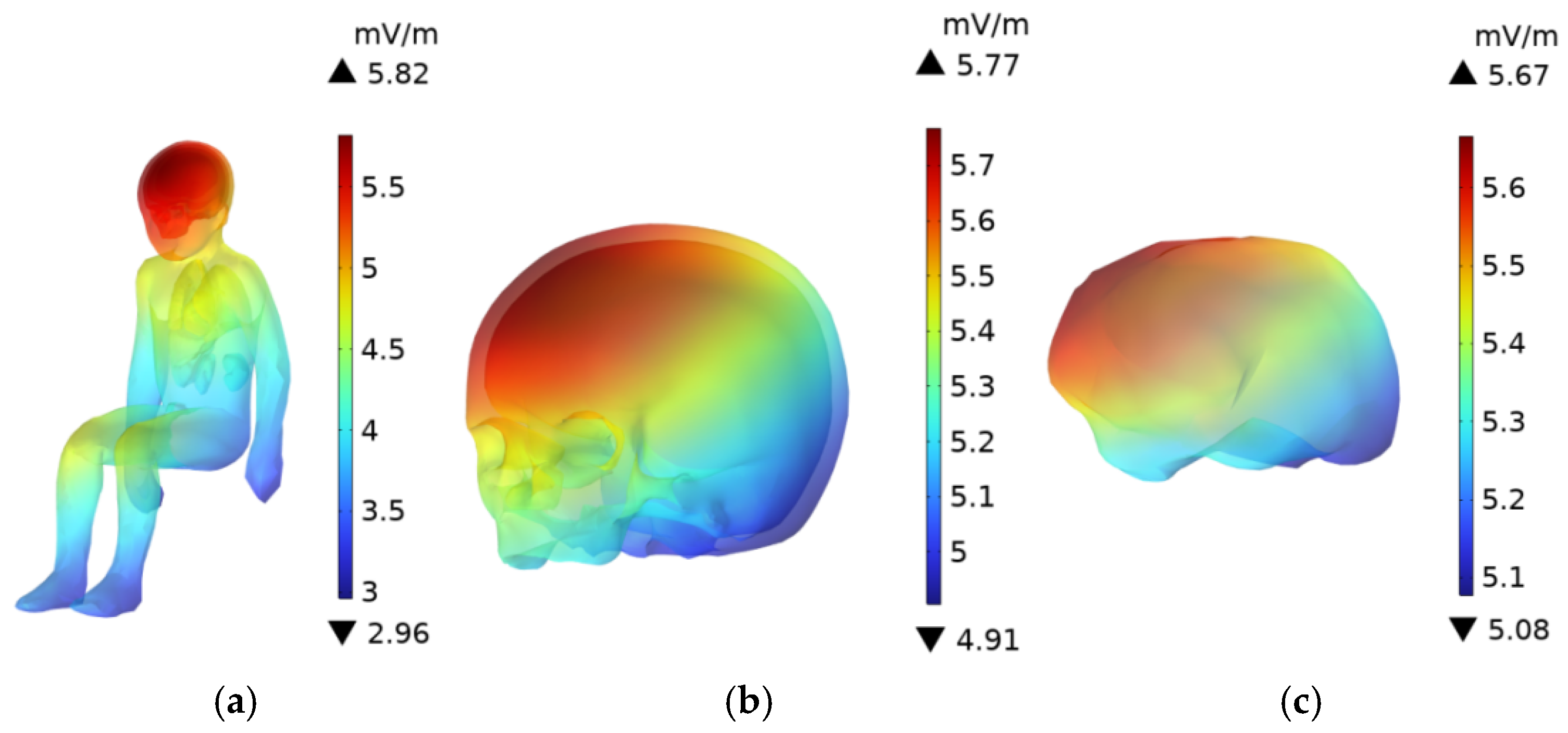


| Main Materials of DC Charging Station and Electric Vehicle | Relative Permittivity | Conductivity (S/m) |
|---|---|---|
| Aluminum alloy (vehicle body) | 1 | 2.33 × 107 |
| Tempered glass | 5.5 | 1 |
| Copper (transformer coil) | 1 | 6 × 107 |
| Ferrite (transformer core) | 10 | 1.54 × 10−1 |
| Human Body Tissue | Relative Permittivity | Conductivity (S/m) (80 kHz) | ||||||
|---|---|---|---|---|---|---|---|---|
| 80 kHz | 85 kHz | 90 kHz | 95 kHz | 80 kHz | 85 kHz | 90 kHz | 95 kHz | |
| Skin | 17598 | 16995 | 16421 | 15876 | 0.05211 | 0.05568 | 0.05915 | 0.06254 |
| Skull | 291.607 | 285.35 | 279.74 | 274.65 | 0.03590 | 0.03592 | 0.03595 | 0.03597 |
| Brain | 3140.9 | 3002.4 | 2878.2 | 2766.2 | 0.10601 | 0.11034 | 0.10691 | 0.10735 |
| Heart | 11670 | 4325.8 | 10662 | 10233 | 0.20850 | 0.21027 | 0.21195 | 0.21356 |
| Liver | 8381.7 | 11137 | 7903.1 | 7693.1 | 0.07988 | 0.08108 | 0.08225 | 0.08342 |
| Kidney | 8637.6 | 8131.6 | 8095.4 | 7863.1 | 0.16714 | 0.16823 | 0.16930 | 0.17033 |
| Lung | 4516 | 8352.1 | 4155.6 | 4002.3 | 0.18705 | 0.18770 | 0.18831 | 0.18891 |
| Electromagnetic Exposure Limits at 80 kHz | |||
|---|---|---|---|
| Exposure Category | Frequency Range | Electric Field (mV/m) | Magnetic Induction Intensity (µT) |
| Occupational | 3 kHz–10 MHz | 21,600 | 100 µT |
| General public | 3 kHz–10 MHz | 10,800 | 27 µT |
| Organs | E(mv/m) | |||||
|---|---|---|---|---|---|---|
| The Distance Between the Person and the DC Charging Station is 0.1 m | The Distance Between the Person and the DC Charging Station is 0.3 m | The Distance Between the Person and the DC Charging Station is 0.6 m | ||||
| Adult | Children | Adult | Children | Adult | Children | |
| Skull | 231 | 156 | 138 | 64.4 | 71 | 28.7 |
| Brain | 169 | 115 | 96.8 | 51 | 51.7 | 24.8 |
| Heart | 158 | 90.4 | 102 | 31.6 | 41.7 | 21.6 |
| Liver | 175 | 87.7 | 92.1 | 28.7 | 38.4 | 22.3 |
| Kidney | 147 | 65.3 | 81.1 | 24 | 32.8 | 24.4 |
| Lung | 185 | 90.8 | 109 | 39.6 | 57.8 | 24.4 |
Disclaimer/Publisher’s Note: The statements, opinions and data contained in all publications are solely those of the individual author(s) and contributor(s) and not of MDPI and/or the editor(s). MDPI and/or the editor(s) disclaim responsibility for any injury to people or property resulting from any ideas, methods, instructions or products referred to in the content. |
© 2025 by the authors. Licensee MDPI, Basel, Switzerland. This article is an open access article distributed under the terms and conditions of the Creative Commons Attribution (CC BY) license (https://creativecommons.org/licenses/by/4.0/).
Share and Cite
Dong, S.; Lu, M. Assessment of Electromagnetic Exposure Levels for Humans from Electric Vehicle DC Charging Stations. Sensors 2025, 25, 5735. https://doi.org/10.3390/s25185735
Dong S, Lu M. Assessment of Electromagnetic Exposure Levels for Humans from Electric Vehicle DC Charging Stations. Sensors. 2025; 25(18):5735. https://doi.org/10.3390/s25185735
Chicago/Turabian StyleDong, Shaowen, and Mai Lu. 2025. "Assessment of Electromagnetic Exposure Levels for Humans from Electric Vehicle DC Charging Stations" Sensors 25, no. 18: 5735. https://doi.org/10.3390/s25185735
APA StyleDong, S., & Lu, M. (2025). Assessment of Electromagnetic Exposure Levels for Humans from Electric Vehicle DC Charging Stations. Sensors, 25(18), 5735. https://doi.org/10.3390/s25185735






